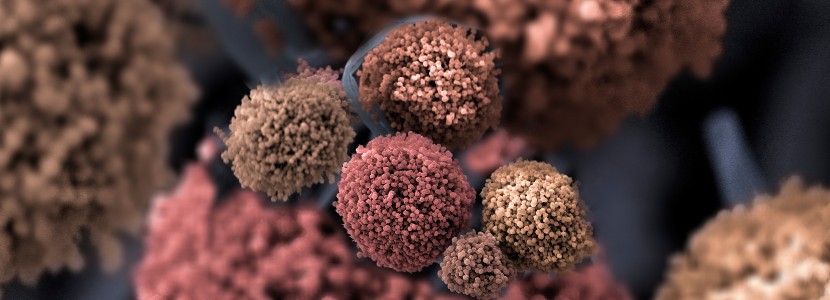Mycotoxin contamination> Mycotoxins are secondary fungal metabolites that can be found in a wide range of raw materials used in human and animal feed.
| Although there are hundreds of mycotoxins, regulatory limits and guidelines for maximum tolerated levels in foods have only been established for a few. |
The acknowledgement of the negative effects of mycotoxins on health and productivity in pig and poultry farming has led to the establishment of maximum tolerance levels for aflatoxins. As well as the creation of regulatory guidelines (recommended tolerance levels) for ochratoxins and a small amount of fusarium toxins.
Limits vary according to:
- mycotoxin type
- animal species
- intended use
- type of raw material
- food and diet
- according to the regulatory body or the country
Mycotoxin analysis
Regardless of the analytical method, mycotoxin concentrations are usually expressed as μg/kg on the basis of dry material. Positive results are those observed in samples which are above the limit of detection (LOD) and quantifiable results are those that are above the limit of quantification (LOQ).
Factors affecting mycotoxin contamination
Mycotoxins are produced by fungi, so virtually all factors that have an impact on fungal development can affect mycotoxin production.
A simplified approach to fungal development and mycotoxin production is to separate fungi into two groups:
- Those that colonize plants before harvest, commonly called field fungi.
- Those that colonize plants or plant material post harvest. Known as storage fungi.
Raw materials are the substrate, and the main factor that influences mycotoxin production by fungi. The second most important factors that determine what type of fungi will develop, are those associated with climate conditions (rainfall, temperature and environmental humidity.)
- For example, in warm and humid subtropical and tropical conditions, corn cobs are colonized by species of Aspergillus flavus and A. parasiticus, resulting in aflatoxin production.
- On the other hand, in temperate regions, maize is a suitable substrate for colonization by Fusarium and the production of fumonisins, deoxynivalenol and other mycotoxins produced by the trichothecene family.
- An example of this, is the correlation between insect damage and F. verticillioïdes infection in corn with its resulting fumonisin levels.
- Host resistance and crop management can also affect the level of mycotoxins found in corn (Cary et al. , 2011).
During storage, temperature, water availability, and insect damage modify mycotoxin content (Bryden, 2012).
Finally,an important fact to take into account when carrying out mycotoxin analysis is associated with the time of year in which such determinations are made. Due to the fact that conditions like rainfall and temperature during that studied period will have a direct impact on mycotoxin content.
[register]
Pig and poultry exposure
Since animal exposure to mycotoxins occurs primarily through feed, and contamination of raw materials used for feed formulation varies considerably, the risk of exceeding regulatory guidelines will vary depending on: the mycotoxin, formulation, and geographic origin of the raw materials used.
Different risk assessment methods and different exposure scenarios can be used.
Nutritional requirements vary with age and the animal species that is under consideration. These variations also have an influence on feed formulation.
Mycotoxin exposure linked to dehydrated whey, synthetic amino acids and vitamins was assessed as zero. The probability that all of the different raw materials used in feed formulation contain the highest levels of contamination, is low. Therefore, if the amount of ingredients used in feed is greater, the probability of exposing animals to high levels of mycotoxins is much lower.
Mycotoxin levels found in feed as a consequence of soybean replacement with other protein sources will vary depending on the raw materials being used:
- Due to the fact that mycotoxin contamination of grape, canola and sunflower seed meal has been shown to be low, their use in feed as soybean meal substitutes does not have a significant impact on total mycotoxin levels.
- In addition, as previously observed in piglets, the use of animal proteins reduces the level of mycotoxins found in feed.
On the contrary, cottonseed meal was found to be highly contaminated with aflatoxins, at least for some areas around the world. Therefore, it must be taken with special caution when considering it a possible replacement for soybean meal.
The risk of exceeding established limits in mycotoxin guidelines for pig and poultry feed are higher for aflatoxins in corn-based diets. This risk will increase if soybean meal is replaced with cottonseed meal.
- Conversely, the use of wheat reduced the calculated levels of aflatoxins in pig and poultry diets.
- Calculated levels of zearalenone were observed above the maximum recommended for corn-based pig diets. However beneficial effects associated with the replacement of corn for wheat regarding this specific mycotoxin were unexpected.
Conclusions
Although the toxicity of mycotoxins in pigs and poultry has been known for several years and there are regulatory guidelines for several of these compounds, there is no data worldwide to compare the levels of mycotoxins in the different foods used at different stages of production.
The calculation of theoretical levels using contamination data from the main raw materials used in food revealed differences depending on the raw materials used, their geographical origin and their intended use.
The choice of raw materials used during feed formulation has important consequences for exposure to mycotoxins and should be carefully analyzed, especially in pig diets.
Complementary data on mycotoxin levels in non-commonly used raw materials are necessary to avoid any risk of overexposure when unusual food substitutions are used.
[/register]
